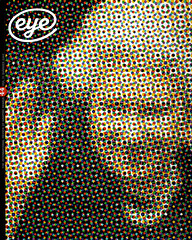Summer 2002
Editorial Eye 44
Why Homer liked graphic design conferences
Simpsons creator Matt Groening recalled why Homer liked to go to design conferences. ‘He used to go to the Aspen design conference and he’d always come back and say how “inspiring” it was.’ When Matt was little, his dad, Homer, was in advertising. These days you can go to a design conference every few weeks – Berlin, Orlando , Brno, Rome, Thessaloniki, Minneapolis – if you want some inspiration. But what kind? The word means an intake of breath, but it’s more commonly used in the sense of ‘artistic inspiration’, a moment in which a divine spark hits the artist, followed by an orgy of creative endeavour. We know it doesn’t work like that. A veteran Hollywood songwriter, asked which came first, the words or the music, replied: ‘The phone call.’
Designers who work on newspapers don’t even wait for the phone to ring, they just get on with it. It’s an everyday area of graphic design that’s rarely examined closely, and there’s no single ‘author’. Yet The New York Times’s response to the tragedy on their doorstep was a fine example of graphic design in daily practice, an ever-changing display of complex texts, photographs, maps, charts, statistics and personal stories that was truly ‘inspiring’. The way that newspaper design is put together, from a ‘kit of parts’, is explored in a visual essay and feature by Simon Esterson, himself a very influential figure in publication design over the past two decades. Designer Phil Baines, in another essay, examines British newspaper coverage of the September 11 attacks.
Pearce Marchbank’s Time Out covers often packed a political punch. A former editor of the magazine recalls that a design briefing session would take no more than five minutes: he would explain the content of the leading article over the phone and Marchbank would immediately suggest an idea. After a brief discussion, the designer would ring off to sort out the photograph, illustration or technique required. But where that anecdote reveals the designer as spontaneous creator, Joe Sacco’s painstaking comic strip dispatches from Palestine show the illustrator as both war artist and front line reporter, working over a long period of time on a project that required patience, bravery and commitment way beyond the normal demands of the design studio.
Voice, the AIGA’s ninth biennial conference, sought to deal with ‘the power of design to effect social change’; to inspire action, and I’m sure it did. Yet some of the most memorable moments were simply great design: Robert Brownjohn’s striking work from the 1950s and 60s threatened to steal the show. Luba Lukova made us look. Golan Levin made us listen as well. And Groening made us laugh. Some visual culture works just by making people feel good, as Miki Kato explains in her essay about the Japanese predeliction for cute (kawaii) icons. But The Simpsons are not Hello Kitty: Groening has cultural power and influence, with a television empire that owes its highly profitable existence to a project that began as marks on paper.
Graphic designers can make a difference. Consider the late Herbert Spencer, whose design, writing and photography, together with the impact of his magazine Typographica, have had an influence that is so great that it is almost invisible, as Ken Garland explains in his memoir. Spencer’s work will continue to be an inspiration, a breath of fresh air, to his friends and colleagues, to this magazine, to designers and writers who hardly knew him, and – through the chains of influence, education and homage – to many more who may never even know his name. JLW
Eye is the world’s most beautiful and collectable graphic design journal, published quarterly for professional designers, students and anyone interested in critical, informed writing about graphic design and visual culture. It is available from all good design bookshops and online at the Eye shop, where you can buy subscriptions and single issues.

